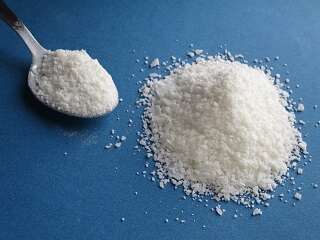What is Stearin?

Stearin, (other names for it - stearine or stearic acid), is a mixture of
fatty acids, used in candle and soap making.
Triple pressed stearic acid has many industrial uses. It's found in many
common cosmetic, skin care, hair and beauty products, e.g. you might find it as an
ingredient in your toothpaste, shaving creams, even in your multivitamins, where it
appears as glyceryl stearate or glycol distearate (chemical compounds of
glyceryl/glycol and stearin).
Naturally occurring in animal and vegetable fats, stearic acid comes from
various sources: Peruvian, Scandinavian, or Japanese fish oils; tallow;
palm stearin, derived from tropical coconuts and natural palm nuts.
The white crystalline substance comes in several solid or granular
forms. It melts and dissolves more easily, as flakes, or a white powder.
How to Use Stearin when Making Candles
How much stearic acid do you add to your
candles? 10 percent - so, you'll need 1.77 oz.
stearin, per pound of paraffin wax. Working with metric weights? Add 100 grams of
stearin to 900 grams of candle wax.
1. Firstly, melt the stearic acid safely in a double-boiler on the stove, or in
a wax melting pot. Colouring your candles? Mix the dye/s in gradually,
little bits at a time.
2. Drip drops of this liquid stearin onto a plate, or the
base of an overturned cup. Leave to set. Check the colour.
3. Happy with the shade and intensity?
Add the paraffin wax to the stearin. Stir
occasionally, while heating up to the required pouring temperature.
Tip: stearic acid's not good for latex moulds, (it rots the rubber). Prolong the life of your flexible moulds...add Vybar instead.
What Does Stearin Do in Candles?
Using stearin in candles vastly improves their appearance and burning properties. Stearin wax plays an essential part in many candle making processes. It produces the longest burning pillar candles, and high quality floating and votive candles. See the benefits of this additive listed below:
- Easier mould release. Stearin increases shrinkage in candle waxes. The set candle pulls away from the sides of the mould slightly, and comes out more easily.
- Intense colour. The ideal amount of 1 part stearin to 9 parts paraffin wax produces candles with vibrant colours. No more muddy pinks and lilacs for you, you'll produce brightly colored candles, and pure pastel shades. Don't add too much - a ratio of 1:4 produces startlingly vivid tones, but might give the wax a soapy appearance.
- Slower-burning candles. Stearin increases the melting point of paraffin wax to 80°C (176°F). Stearine candles burn longer, with steady, unwavering flames.
- Less drips and smoking. Candles made from stearic acid are virtually dripless. They burn with smaller, neater flames, emitting less trails of smoke. You'll spend less time cleaning waxy messes off your cloths and tables. And best of all?...you'll be spared the damage of candle soot on walls and ceilings.
- Harder candles. Stearin candles can take hot weather - they keep their shapes, without melting and bending.
So, there's your secret to successful candles. Mixing
stearin into your waxes has many advantages. This valuable additive is a
powerful weapon in your candle making arsenal!
Take Note: I have only combined stearin with paraffin waxes, and have no
idea what stearin does, or how it acts, when mixed into other types of waxes.
References:
Candles, by Jon Newman. This informative book contains extensive
references to stearin, and contains various historical facts; definitions and
characteristics of; the composition of; the uses of stearine in candle making.